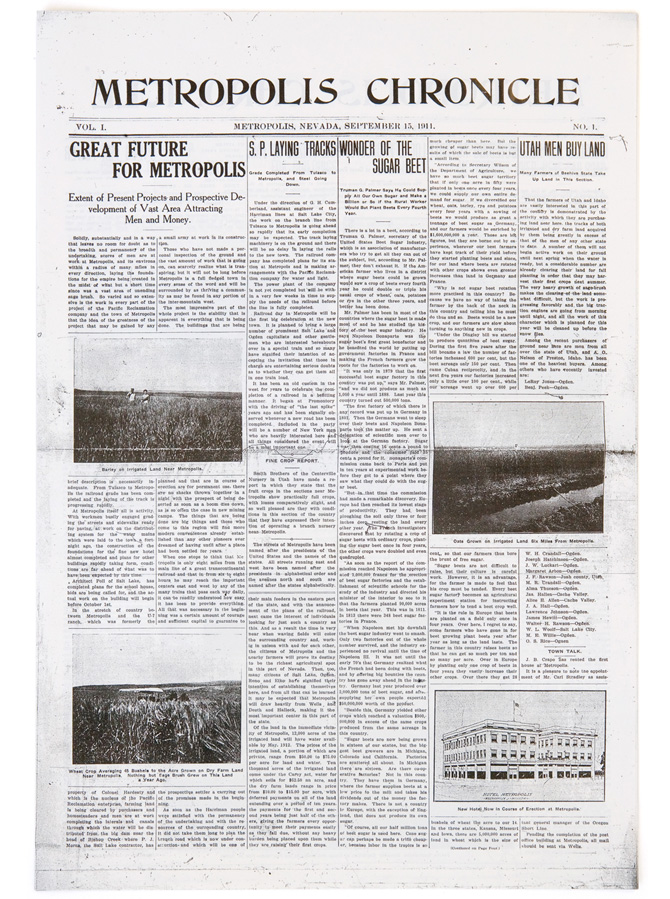
Reclamation was an exploration of the nature of monuments, ruins, and financial bubbles. The artwork encompassed both a large-scale architectural sculpture—a 1:1 reproduction of the last façade from the ghost town of Metropolis, USA—and the republishing of original promotional materials from Metropolis.
Metropolis was founded in 1910 by a group of East Coast financiers with an epic civic vision. In the midst of Nevada’s remote and arid high desert, they imagined a bustling, modern new city surrounded by an oasis of agriculture.

They went to extraordinary lengths to realize this vision. After incorporating as the Pacific Reclamation Company, they built the city's infrastructure from scratch, constructed the world’s then fourth-largest dam to serve as its water supply, and convinced the Southern Pacific railroad to build a spur off the transcontinental line to serve Metropolis.
The city of Metropolis was realized on a scale unparalleled in the late-gold-rush West. It quickly swelled with thousands of settlers attracted by the promise of cheap land and a better life.
Then, in 1912, just two years after its founding, the Pacific Reclamation Company went bankrupt. The financiers hadn’t secured the rights to the water they’d promised settlers. In fact, the majority of the promises in their advertising had been empty, or worse. As quickly as it had boomed, the bubble burst.
Today, the last and most permanent building in Metropolis, the Lincoln School, has almost completely crumbled to the ground. Pockmarked with bullet holes and corroding in the harsh desert weather, only the entrance to the school remains standing in the shape of an arch.
Through a commission from Museum De Paviljoens and the Van Eyck, NL, I undertook the monumental project of reconstructing the last remnant of Metropolis—the arch—at 1:1 scale.
I photographed every inch of the archway’s surface, processed thousands of the resulting photographs, and printed them out across many hundreds of feet of adhesive vinyl. Then, I oversaw the construction of a two-story, full-scale plywood replica of the decaying Lincoln School arch. And finally, together with an assistant on-site, I applied the hundreds of sheets of high-res photographs across the sculpture’s full surface. The result was an almost hallucinatory experience, as if a video game architecture had somehow been teleported into 3D space.



Reclamation was located on SITE 2F7, the last remaining undeveloped plot of land in the city center of Almere, NL. Almere is a recently-founded, rapidly expanding Dutch city built on land reclaimed from the sea. Founded in 1978, Almere is on track to become the fourth largest city in the Netherlands. In other words, this two-story “new ruin” haunted a still-quite-new European city.
The artwork juxtaposed two frontiers and land reclamation projects—Metropolis and Almere—and highlighted their similarities and differences. In both cases, the city's nascent identity launched, attracted attention, and grew through a blend of storytelling and marketing. Reclamation explored a web of related themes, including real estate as reclamation, the history of frontiers and financial bubbles, and process by which value is created.


- Made possible by
- Museum De Paviljoens
- and the Jan van Eyck Academie
- With additional thanks to
- The Center for Land Use Interpretation
- Enough Room for Space
- LOCALISMS
- Max Designs
- Bouw2000 BV
- Ingenicon BV
- Scope Bouwmanagement BV
- The Municipality of Almere
- Wells Chamber of Commerce
- City of West Wendover
- The Utah State Historical Society
- University of Nevada Libraries, Reno
- Ron Bernstein, Coordinator Materials, Jan van Eyck Academie
- Jo Frenken, Coordinator Graphic Productions, Jan van Eyck Academie
- Anouk van Heesch, Artistic Coordinator, Jan van Eyck Academie
- Annick Kleizen, Assistant Curator, Museum De Paviljoens
- Macha Roesink, Director, Museum De Paviljoens